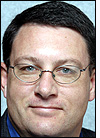At its facility in Baton Rouge, La., beverage and dairy product manufacturer and distributor Dairy Fresh uses a system that automatically tags cases and pallets headed for RFID-using distribution centers and retailers, including such customers as Wal-Mart.
“We wanted something that would require the least amount of manual labor,” says Dairy Fresh IT Director Ricky Justice. A manual tagging solution, he explains, would require too much labor to apply the labels, and would not be sufficient when Dairy Fresh eventually shifts to applying RFID labels to all its shipments. “We didn’t want to have to go back and revisit this project once all of our customers are accepting RFID tags in the future,” he says.
The company chose an XARM (Xterprise Automated RFID Module) 4000 automatic label-application system, provided by Xterprise. The system has been up and running since April 2006. After receiving an RFID order, a Dairy Fresh employee on the assembly floor switches on the XARM system to begin applying RFID tags at the case level. Referencing a paper order form, the employee enters the quantity and product types being sent through the assembly line, destined for an RFID-enabled customer.
Once the product has been bottled and packaged within the assembly line, it passes down a conveyor belt. An RFID label printer-applicator prints the label, encodes its tags and attaches the label onto the carton. At the end of the assembly line, an RFID interrogator (reader) verifies the label’s unique RFID number and ensures that any box passing through the line gets tagged. At the point of pallet aggregation, a separate RFID interrogator collects all the cases’ RFID tag numbers once more. When the boxes intended for RFID tagging have passed through the assembly line, the system automatically switches off.
Dairy Fresh will be using about 250,000 tags during its first year, Justice estimates. The firm has installed the system to run on two manufacturing lines in the Baton Rouge facility.
The XARM 4000 uses a Service Oriented Architecture (SOA) software platform, says Dean Frew, Xterprise president and CEO, designed to allow Dairy Fresh the flexibility of having automated tagging when needed. The XARM is a stand-alone system that does not tie into the company’s ERP system.
Dairy Fresh is using two Weber Marking Systems RFID label printer-applicators. Each device utilizes a Zebra Technologies print engine to encode the EPC number and print it on the label, then blows the label onto the box. The company is also using Zebra desktop printers to print and encode RFID labels, which are manually applied to the pallets.
Alien Technology is supplying labels embedded with its Squiggle Gen 2 UHF inlays, as well as Alien 2800 readers and antennas for tag verification and aggregating cases on pallets. The system can apply tags to cases at a rate of 15 to 20 per minute, Frew says. The cost per case of using the system is about one-third to one-fourth the cost of the slap-and-ship method, he adds, though he and Justice are unwilling to provide an exact price. “We stayed within our budget and received the type of RFID system we needed and wanted,” Justice says.


